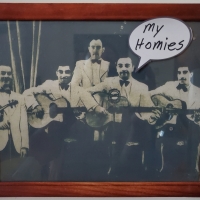DjangoBooks.com
Welcome to our Community!
Categories
- 20K All Categories
- 1.1K General
- 478 Welcome
- 59 Archtop Eddy's Corner
- 146 CD, DVD, and Concert Reviews
- 385 FAQ
- 26 Gypsy Jazz Italia
- 27 Photos
- 207 Gypsy Picking
- 21 Unaccompanied Django
- 15 Pearl Django Play-Along Vol.1
- 17 Gypsy Fire
- 45 Gypsy Rhythm
- 1.4K Gypsy Jazz University - Get Educated
- 131 Gypsy Jazz 101
- 228 Repertoire
- 224 History
- 708 Technique
- 51 Licks and Patterns
- 6 Daniel Givone Manouche Guitare Method Users Group
- 20 Eddie Lang Club
- 1.3K Gypsy Jazz Gear
- 805 Guitars, Strings, Picks, Amps, Pickups and Other Accessories
- 461 Classifieds
- 50 Recording
- 62 Other Instruments
- 18 Violin
- 5 Mandolin
- 22 Accordion
- 7 Bass
- 10 Woodwinds
- 348 Gypsy Jazz Events
- 143 North America
- 110 Europe
- 95 International
In this Discussion
Who's Online (0)
Compound fretboard radius?
Hello. Just wanted to run a little notion through the collective wisdom filters on here. I'm planning a refret on my guitar soon, from the vintage narrow I have now to a medium jumbo, and am pretty set on the Evo Gold wire. So I've been musing for some time on whether there are any subtle tweaks I could make to the board to enhance playability. For example I'm thinking of rolling the edges just very slightly to help with thumb-overs etc. Easing the feel of the width without changing the width as it were. So nothing drastic.
Then I began to wonder if there was any reason why I shouldn't consider the radius as well. The flatter boards of these guitars obviously echo the classical heritage of their origins, but is this just convention, or are there any practical reasons why this aspect should be adhered to? I feel like I would enjoy a little more camber around the first position especially, but of course this is not an adjustment you can try out and then reverse out of.
I'm told Collings guitars have a compound radius of 12"-17". Sounds pretty well thought out to me. I believe the Selmer spec is 16", am I correct? I don't know the radius on my guitar, but it's pretty flat. My feeling is that this modification might gently improve playing comfort whilst not radically altering the guitar.
I've pored through the treasure trove of expertise and opinion on these forums and have gained much enlightenment, but have never seen this discussed. So, any builders, techs, seasoned tweakers out there have anything to say on this? Maybe people are doing this already. Or, at the very least, could someone just shoot down this idea before I screw up my guitar!
Thanks for listening.
Then I began to wonder if there was any reason why I shouldn't consider the radius as well. The flatter boards of these guitars obviously echo the classical heritage of their origins, but is this just convention, or are there any practical reasons why this aspect should be adhered to? I feel like I would enjoy a little more camber around the first position especially, but of course this is not an adjustment you can try out and then reverse out of.
I'm told Collings guitars have a compound radius of 12"-17". Sounds pretty well thought out to me. I believe the Selmer spec is 16", am I correct? I don't know the radius on my guitar, but it's pretty flat. My feeling is that this modification might gently improve playing comfort whilst not radically altering the guitar.
I've pored through the treasure trove of expertise and opinion on these forums and have gained much enlightenment, but have never seen this discussed. So, any builders, techs, seasoned tweakers out there have anything to say on this? Maybe people are doing this already. Or, at the very least, could someone just shoot down this idea before I screw up my guitar!
Thanks for listening.










Comments
Thanks Jazzaferri.
Anyway. With all of the crazy chords that we grab in this music, I am surprised that smaller radii are not more common. I have trouble grabbing certain chords comfortably on GJ guitars (min6/9 anyone?), yet I can nail just about any chord easily on my strat, and I never even gave fretboard radius a thought until this thread. Good one @martin b. I'd also like to hear others weigh in on this.
That's all apples and oranges of course. In my view, for those of us coming in from playing American style guitars, the longer scale length is the main challenge and requires the most adjustment, and is what makes some of those chords a real stretch. I'm just thinking this might make clean chording a little easier.
I am now refretting with a flat ebony board as I don't have the skills and tool to do a compound radius and I'm not confident that I would get the radius calcualtions right. My other alternative is just to get a luthier to do it. Good luck to all of you with your refrets/new board.
You can do a sort of compound radius yourself with a series or radiused sanding blocks and then finish off by blending the radii with a flat sanding board.
Ebony is tough to hand sand. Put on a CD and take your time. Check your progress often. You can't put the wood back on very easily.